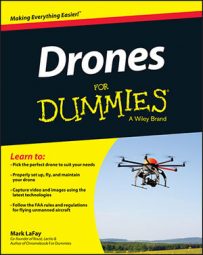When it’s time to take flight, make sure you are familiar with the different flight modes on your drone. There are several different names and terms to refer to the different flight modes for your drone.
Standard mode
Standard mode, also known as Normal mode (and other names), is the most common flight mode. And probably the safest for new pilots. To put it simply, standard mode controls function as if you were sitting in the cockpit piloting the control.
The controls are relative to the front of the drone. Inexperienced pilots can get into trouble in this mode because when the drone is facing the pilot, the controls can seem to be reversed. Just remind yourself that you are always flying from the perspective of being in the pilot seat.
Heads free mode
When your drone is in Heads Free mode, also known as Simple mode or Carefree mode, your controls are set based on the orientation of the drone when it was armed. For example, if your drone was facing north and you were standing behind it, forward will always send it north, backward will always send it south; the same goes for the side to sides.
This can be somewhat confusing, but it can come in handy in the event your drone is ever far enough away that you can’t determine the direction it is pointing (heading).
First person view
First person view (FPV) is a new flight mode for consumer drone fliers. In FPV mode, the pilot is able to fly using the onboard cameras acting as his eyes. The camera is typically a narrow focus, front-facing camera, giving the pilot the ability to pilot the craft as if he were onboard and behind the controls. In order to fly in FPV mode, your drone must come with a front-facing camera.
Your drone must also have the option for live streaming the video feed to a display device. This almost always requires a Wi-Fi connection which then places a restriction on the distance you can fly in FPV mode to about 600 meters or less.
The FAA hasn’t placed an official ban on FPV flying, but the law specifically says that if you are hobby flying, you must fly line-of-sight. That said, if your drone offers FPV flight mode and you want to limit your risk of potentially getting busted, you should fly out in the middle of nowhere.
![First person view is a fun flight mode. [Credit: Source: Daniel Zimmermann/Creative Commons]](https://www.dummies.com/wp-content/uploads/482962.image0.jpg)
Other flight modes and autopilots
There are several different modes in which you can fly your drone aside from the more common modes like standard and heads free. Unfortunately, there isn’t a standard set of terms for how to describe the different modes, and so one vendor may call it one thing and another vendor will call it something totally different. For example, GPS lock mode is also referred to as loiter mode. Following is a list of other flight modes and some autopilot modes
Altitude Hold mode: In this mode, your drone’s current altitude will be maintained. Roll, pitch, and yaw will operate the same, but the altitude will remain constant.
Loiter mode: In this mode, your drone will automatically maintain your location, heading (where you are headed), and altitude even after your hands have been taken off the control sticks. The pilot can fly loiter mode as if it is in a manual mode, but you don’t have to worry about a crash if you take your fingers off the sticks mistakenly.
Stabilize mode: This mode allows you to fly your drone manually. The drone will automatically level out after you make directional corrections, however. When you roll or pitch a drone, it causes the drone to lean the device in order to move in that direction. In a fully manual mode, you would have to level out the pitch or roll manually. Stabilize mode does this automatically.
Auto Return mode: Numerous drones offer a feature that will cause your drone to fly back to the place where it was armed in the event that control communication is lost. This feature is usually initialized by default, but refer to your manual to ensure that it is; otherwise, you could lose your drone if you get out of range or lose battery power in your controller.

